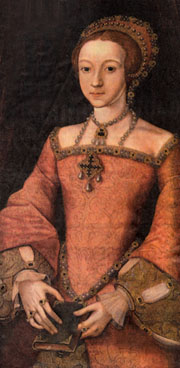
Elizabeth I: Much loved queen of England
We have featured several great queens in this page. Another
remarkable monarch who shouldn't be forgotten is Queen Elizabeth I of
England. She is a person who contributed much to the development of her
country; in fact, her reign was called the Golden Age of England.
She was very popular during her reign and is still held in high
esteem by the British. She managed to become one of the best loved and
admired rulers of all time and was well known for her remarkable
achievements and abilities. The Queen became a legend in her lifetime.
Princess Elizabeth was born as Elizabeth Tudor, the daughter of King
Henry VIII and his second wife, Anne Boleyn on September 7, 1533 at
Greenwich Palace. However, since her father had been hoping for a son,
her early life saw the young girl enduring many hardships. After her
mother's death, she was even stripped of the title 'princess' and was
referred to as simply 'Lady Elizabeth'.
However, she received a very good education as the nobility of the
day believed in providing an equal education to both girls and boys. She
and her younger half-brother, Edward VI (heir to the throne), were
educated together, and she learnt, among other things, Greek, Spanish,
French, history, philosophy and mathematics. She did very well in her
studies and had a special flair for languages; she was said to be fluent
in five languages. Elizabeth had shown her talents in aesthetic subjects
as well, with musical instruments, needlecraft and art, being some of
her talents.
After her father died in 1543, people started using her as a
political pawn. After the death of King Edward VI, her half-brother,
from ill health in 1553, Elizabeth's half-sister Mary ascended the
throne.
There were rumours of a rebellion against her in which Elizabeth was
also said to be involved. Thus, she was arrested for treason(betraying
country or ruler) and imprisoned at the Tower of London, despite
pleading her innocence. However, there was no evidence against her and
also, she was popular among the public, so, about a year later, she was
released.
With Mary's death, Elizabeth finally succeeded to the throne on
November 17, 1558 at the age of 25, and was crowned at the Westminster
Abbey on January 15, 1559. Being a Protestant, one of her first steps
was to re-establish the Protestant Church and restore the national
coinage, which had then been under-valued. Although she became the
Supreme Governor of the Church of England, she never persecuted people
with other religious beliefs.
The Queen was also a lover of sports, especially horse racing, music
and dancing. She contributed much to the field of art by creating
theatres with the proper atmosphere to stage artistic creations.
Although Elizabeth received many offers of marriage, she declined them
all.
The succession of stepmothers she had during her early years may have
contributed to her viewing marriage in a dim light.
Queen Elizabeth I was dedicated to her country, unlike many other
monarchs. She had political genius and also selected capable people to
assist her to run the country. She always listened to others' advice and
would even change a policy if it wasn't favourably received.
She was adept(skilful) at winning wars too. When she ascended the
throne, England was a poor country torn apart by religious problems, but
when she died on March 24, 1603 after ruling the country for 44 years
and four months, England was one of the most powerful and prosperous
countries in the world.
She died at the age of 69 and was buried at Westminster Abbey. Since
she had never married or had children, she had no heir, and thus had
left instructions that James I, the son of Mary Queen of Scots, should
succeed her.
This much loved monarch is referred to as the Virgin Queen, Good
Queen Bess, Gloriana and Elizabeth the Great. A famous quote attributed
to her is "I may not be a lion, but I am a lion cub, and I have a lion's
heart".
'Soft side' of Elizabeth I revealed
A rare portrait depicting Elizabeth I as an innocent teenager rather
than a powerful queen has been rediscovered by an expert, more than 450
years after it was painted.

Portrait of Queen Elizabeth I when a Princess went on display for the
first time in London, recently. Its discovery by Philip Mould, an art
dealer, has been described as "important and exciting" by Dr David
Starkey, the historian and television presenter who has written a
biography of Elizabeth's early years.
The picture by an unknown artist is only the second known portrait of
Elizabeth as a young princess - the other is in the Royal Collection -
and projects a softer image, very different from the later paintings
showing her as a strong monarch.
Mould, who has a gallery in London, bought the painting after it had
been in a private collection in Spain for more than 40 years.
Having bought the picture, he brought in forensic experts and a
restorer to unravel its history. The breakthrough came when analysis of
the wood on which it is painted revealed that the oak tree had been cut
down as early as 1546. Such panels were normally used soon after
felling, and so, the portrait was probably produced about 1547.
That was the year when Elizabeth, who was then 14, went to live with
her stepmother, Catherine Parr, following the death of her father, Henry
VIII.
"This painting shows us the human face behind Elizabeth's mask,"
Mould said.
The Daily Telegraph |


